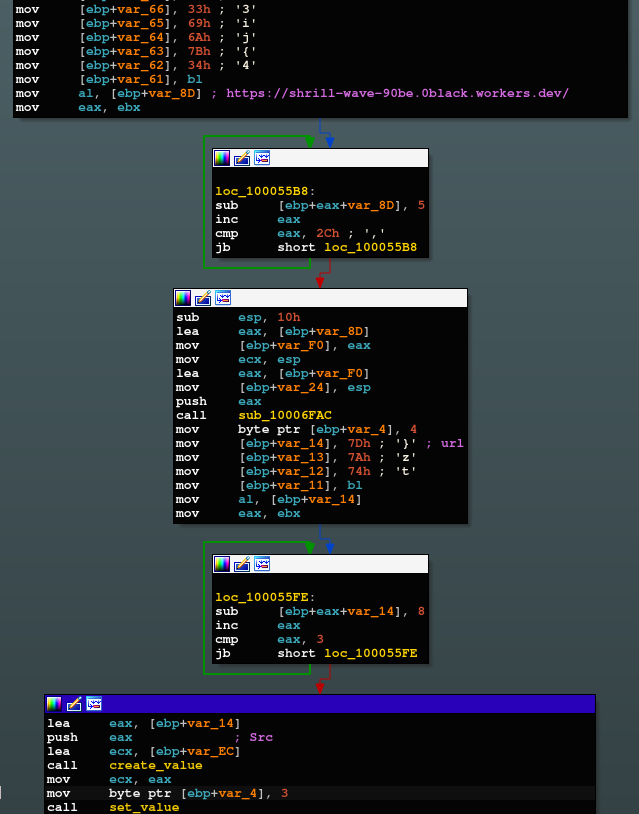Introduction
On 27 November, QuoIntelligence detected a new malware, seemingly uploaded to VirusTotal by a user in Turkmenistan, which shares multiple similarities to the threat actor we previously dubbed ReconHellcat. The campaign ultimately delivers a previously undocumented remote access Trojan (RAT), which we dubbed BlackSoul. After promptly alerting our customers, we notified Cloudflare about the C2 infrastructure hosted on their Workers service as per our responsible disclosure process.
Further analysis revealed the malware being part of a targeted campaign, that likely originated with a spear phishing email delivering a CAB archive. Both the CAB and the file contained within are named 1-10-20-hb44_final to impersonate one of the documents available on the National Institute of Standards and Technology (NIST) website.


Technical Analysis
Loader.ReconHellcat
| File Name | 1-10-20-hb44_final.exe |
| SHA256 | 3be1dd49f01e8b7ddf9af765693690d44356399b9e6043e51d5e13c82194b2a4 |
| First Submission to VT | 2020-11-27 10:41:21 |
| First AV detection rate | Low (10/71) |
During our analysis, we determined 1-10-20-hb44_final.exe is a malicious loader, which uses obfuscation similar to the variant observed in the previously reported ReconHellcat campaign delivering BlackWater malware. Another similarity is that the loader utilizes C2 infrastructure hosted on the Cloudflare Workers service. Following a successful C2 connection, the loader retrieves two files: (1) an executable named blacksoul, and (2) a Dynamic-Link Library (DLL) named blacksoulLib. Additionally, the loader opens Microsoft Word with the aforementioned legitimate document from the NIST website. Essentially, ReconHellcat uses this legitimate document as a decoy. The blacksoul and blacksoulLib files have compilation timestamps from 27 and 26 November, respectively.
BlackSoul
| File Name | Bl4ck_S0ul6s5_1d7704b469.blacksoul |
| SHA256 | c49cad471a61adb5ea8a6d260887d1dd7f22de75d1143ce2a72828842ef4bb52 |
| First Submission to VT | 2020-11-29 18:23:26 |
| First AV detection rate | Low (18/71) |
The second stage executable is a newly observed malware family, which we linked to the ReconHellcat threat actor. We named the malware “BlackSoul” to match its internal name, main class name, and file name.

The malware is a classical minimal RAT, which is capable of file transfers and running arbitrary commands. Through static analysis, we determined that the executable’s main loop supports handling the following commands from its C2 server:
| Command Field Names | Actions Taken | |
| 1 |
params |
Executes a command and return the result. |
| 2 | url and path or media and alternativeText | Downloads file(s) from a URL and stores them in a destination on the machine. Creates a destination folder if it does not already exist. |
| 3 | paths | Likely retrieves a specified file from the machine and uploads it to the C2. |
| 4 | config | Updates the configuration file (UsrClass.json) which contains C2 server info and miscellaneous fields. |
BlackSoul makes use of two files:
- UsrClass.json: Contains a JSON configuration. It is unclear if this file is mandatory or merely used to save existing configurations between invocations of BlackSoul.
- UsrClass.data: Observed as a DLL with an Init() export, which we refer to as blacksoulLib and will describe in depth in the next section.
BlackSoul uses information gathered by blacksoulLib to call back to the C2 over the RESTful Strapi protocol and JSON based data encoding.
The RAT’s string obfuscation applies only to strings in the main program but excludes strings of third-party compiled in libraries. BlackSoul additionally uses various other techniques for obfuscation. In particular, strings are constructed dynamically on the stack and deobfuscated with a variety of mechanisms, such as a fixed key XOR cipher and a Caesar cipher using variable shift values.
blacksoulLib
| File Name |
Bl4ck_S0ul6s5_faac59ebe2.blacksoulLib |
| SHA256 |
fdd310ce1b4f03a79f7a6eda8df793f4c0718766228a9a0700cf0b5a4ea648e2 |
| First Submission to VT |
2020-11-26 23:45:57 |
| First AV detection rate | Low (18/71) |

The file is a DLL with a single export, Init(), which is called by BlackSoul. In this instance, its primary functions are:
- Searching the victim’s machine for Firefox, Chrome, and Opera data. If the browser data is not found, the program terminates early.
- Decoding a C2 URL later used by BlackSoul
- Decoding a Cloudflare DNS-over-HTTPS (DoH) URL.
- Generating further login information for the C2 and returning gathered data to BlackSoul in JSON format, including:
- A username with three random appended characters.
- A password consisting of 24 random characters.

Based on our observations, the DLL’s specific functionality adapts to various victims’ environments, and the DLL outputs different C2 information for various targets.
Victimology
QuoIntelligence was unfortunately unable to uncover the entities targeted by this campaign. The only information at hand relies on:
- The VirusTotal submitter’s country (Turkmenistan)
- The theme used as a lure (NIST)
Due to the limited information available to determine victimology, we cannot definitively state a target. However, it is likely that the BlackSoul campaign targeted a government-related body based on the theme lure, since NIST develops and publicizes security compliance standard for the US Federal Government and any organization who handles government data. As well, previously observed ReconHellcat campaign targets consisted of primarily defense and diplomatic government bodies.
Attribution
When we initially discovered ReconHellcat, its campaign characteristics and Tactics, Techniques, and Procedures (TTPs) were unique enough to classify it as a new threat actor. During our analysis of the new BlackSoul campaign, we identified limited yet sufficient similarities overlapping with the earlier observed BlackWater campaign. As a result, we have high confidence attributing this attack to ReconHellcat.
Similarities to earlier ReconHellcat campaigns:
- Lure themes of government related organization materials.
- Usage of compressed archives, likely via spear phishing email links or attachments, to distribute the initial attack artifacts.
- A three-stage attack scheme.
Similarities between ReconHellcat‘s BlackSoul and BlackWater malware:
- Supports DNS-over-HTTPS (DoH) using cloudflare-dns.com.
- Has clear internal naming likely due to a lack of artifact cleanup in the malware build process.
- Resolves the C2 hostnames via DNS over HTTPS (DoH) using a built-in feature of libcurl, aclient-side URL transfer library.
- Contains paths and parameters to use Strapi – a content management system (CMS).
- Identical string obfuscation.
- Uses Cloudflare Workers Service (*.workers[.]dev) to host C2 infrastructure.
- JSON–encoded communications.
- Similar kind of randomized login (user registration) scheme with the C2 server.
- Malware samples contain a ‘Black’ prefix in their naming schemes.
To note, although we have not found a strong correlation or technical link between ReconHellcat and APT28, there are shared characteristics between the two groups, which we highlighted in our recent APT28 reporting.
Appendix I – IOCs
hxxps://noisy-haze-af47.fromhell.workers.dev/uploads/Bl4ck_S0ul6s5_1d7704b469.blacksoul
hxxps://noisy-haze-af47.fromhell.workers.dev/uploads/Bl4ck_S0ul6s5_faac59ebe2.blacksoulLib
hxxps://shrill-wave-90be.0black.workers.dev/
Loader.ReconHellcat
3be1dd49f01e8b7ddf9af765693690d44356399b9e6043e51d5e13c82194b2a4
BlackSoul
c49cad471a61adb5ea8a6d260887d1dd7f22de75d1143ce2a72828842ef4bb52
blacksoulLib
fdd310ce1b4f03a79f7a6eda8df793f4c0718766228a9a0700cf0b5a4ea648e2
MITRE ATT&CK
| TACTIC | TECHNIQUE |
| Initial Access |
T1566: Phishing |
| Execution |
T1204: User Execution |
| Defense Evasion | T1027: Obfuscated Files or Information |
| Credential Access |
T1555: Credentials from Password Stores |
| Discovery | T1082 System Information Discovery |
| Collection | T1005: Data from Local System |
| Command and Control | |
| Exfiltration |
Do you want to stay informed of cyber and geopolitical threats targeting your organization? Are you interested in receiving exclusive and unpublished intelligence?


